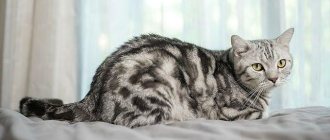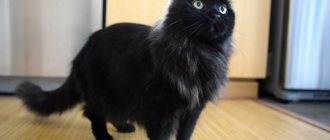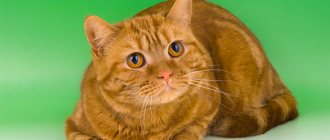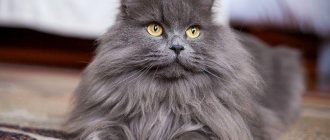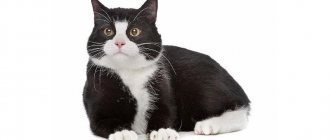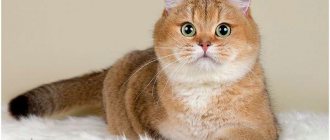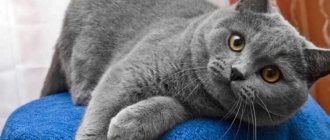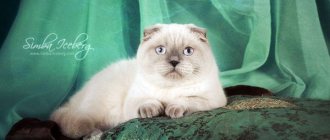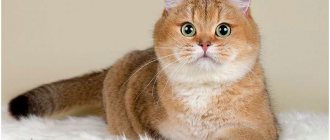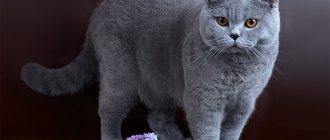Care and maintenance
Before you get a Briton, it is important to purchase all the accessories necessary for him:
- Sleeping area. Representatives of this breed love to be alone, so it is recommended to buy them a bed or a house, which should be placed in a secluded and quiet place.
- A bowl. Metal utensils with high sides are suitable for food, and ceramic ones for water.
- Tray. Breeders advise using a plastic high box. It is recommended to choose the filler from wood material.
- Comb. It is better to comb a soft, plush fur coat with a massage brush.
- Cloth. The British have a hard time withstanding frost, so it is worth purchasing a warm wardrobe for winter walks.
- Scratching post. It will help wean furry ones from the habit of sharpening their claws on furniture.
If the animal gets used to being in human hands, it will be easier for the owner to care for it.
When you get a British tortoiseshell cat, first of all you should establish a chain of command between the owner and the pet. If the rules of behavior are followed well, it is recommended to reward your pet by treating him with a treat. If the cat misbehaves, you should immediately scold him without using force. Despite the fact that this breed is distinguished by its cleanliness, the kitten needs to be taught to handle hands in order to calmly care for its eyes, ears, and claws, where the tortoiseshell fold cat cannot reach on its own.
Caring for British cats is not difficult, but it is worth remembering and observing some nuances. The main advantage of the breed is its coat. The animal should be combed 1-2 times every 7 days. With a special brush you can remove any loose hair and massage your furry friend. In addition, it is necessary to trim the nails twice a month, even if there is a scratching post.
You should clean your eyes with a damp cotton swab every day to avoid accumulation of discharge.
The ears also need to be paid attention. Use a cotton swab dipped in boiled water to treat the ears.
You will need to examine your mouth every day. If tartar deposits are noticed, dry food should be introduced into the diet, which successfully copes with this problem.
An important aspect of caring for cats is nutrition. Many owners prefer to feed their pets industrial complementary foods. Such food contains all the necessary vitamins and microelements. The main thing is that the tortoiseshell cat, in addition to this food, receives a sufficient amount of liquid. If your pet eats only natural products, then the diet should include raw lean meat, boiled fish and chicken, cereals and vegetables. You should feed your pet 2-3 times a day.
Existing types of “turtles”
The term tortoiseshell cat implies a type of coat color, but not a breed. Tortoiseshell is the result of mixing three colors in unpredictable combinations. The main components are black and red or tan. As well as light colors derived from them - cream and silver, sand and ash or white.
Types of tortoiseshell color:
- Scaly or Torti, in which black and red colors overlap one another without forming a clear outline, and the pattern resembles scales on a fish. One of the colors remains dominant, and a 50/50 ratio is rare. This type of cat color is more typical of Persian, Siberian and yard breeds.
- Patchwork or Calico, when the combination of black and red looks like a patchwork quilt. The spots are located chaotically and are clearly expressed. This color can be seen in Scots, Devon Rex and British.
- There are colors with distinct white spots mixed with the main black and red color. They can be located in the lower part of the body, while the classic tortoiseshell color predominates in the upper part.
Tortoiseshell colors are found in solid and patterned patterns. In the patterned version, in the middle of the spots there is an additional ornament, which is not present in the plain tortoiseshell color.
Tortoiseshell color is found in short-haired and long-haired cats of these breeds.
Longhair:
- Persian
- Norwegian
- American Coon or Maine
- Angora
- Kimryskie
Shorthairs are:
- British
- Cornish Rex
- Sphinxes
- Scottish Fold
- Japanese Shorttails
- Eastern
Silver colors
Additionally, shaded, chinchilla and smoky subspecies are distinguished in this category. In smoky hair, the color is uneven, the main tone occupies about a third of the length of the coat, while the undercoat and the main part of the hair are painted white or light silver. The nose pads and nose are pigmented to match the coat. Eyes are different shades of orange.
In chinchilla cats, a light “spraying” can be seen at the ends of the hair (1/8); in shaded cats, this shade occupies approximately a sixth of the length. Pets with a color a la chinchilla have bright green eyes, while shaded ones have eyes from light honey to orange. A defect is considered to be the presence of stripes or patterns. With a shaded color, uniformity of color on the back, muzzle, tail, and sides is important; minor differences on the belly are acceptable. The pigmentation of the pads and nose is only black. This color can be either plain or tortoiseshell.
A little mysticism
Most peoples around the world endow the tortoiseshell cat with magical properties. It is believed that “turtles” attract good luck and protect the home from misfortunes. With a pet “turtle,” the house becomes cozy and calm. And if such a cat gets in by accident, then it is prohibited to kick it out. And what sane person would refuse happiness and good luck.
In Japan, such cats are iconic, they are worshiped and legends are made about them. Almost every Japanese home has a maneki-neko figurine. This is what the locals called the tortoiseshell-colored cat. They believe that such an animal is sent on a special mission and the presence of a “turtle” in the house, even in the form of a figurine, will allow them to receive the protection of higher powers. Japanese sailors are trying at any cost to get a turtle pet that will help them avoid a dangerous storm along the way.
In popular beliefs, the tortoiseshell cat is considered a symbol of grace and luck, a protector from troubles, fires and floods. “For luck” they try to take the “turtle” cat.
A colored miracle in the house will definitely become a devoted friend and bring prosperity.
Features of character and behavior
The results of many years of observations have shown that tortoiseshell color leaves an imprint on cat habits. Animals with motley fur coats are endowed with an easy-going and friendly disposition. At the same time, the proud and independent nature of cats with tricolor hair does not allow them to do anything against their will.
Such animals quickly become attached to their owners and are sensitive to changes in the mood of the household. Tortoiseshell cats can be soothing with their purring and will not be intrusive at the wrong time.
Care
Blue Britons require care in several ways.
- It happens that discharge occurs around the eyes, and this occurs in both kittens and adults. For cleaning, use a cotton swab previously soaked in an eye wash solution. If the discharge is purulent in nature, then your pet should definitely be shown to a veterinarian.
- Ears also require care. In normal condition, they should be clean, odorless and uniform in color. To clean your ears, you need to take a cotton swab dipped in a special solution.
- To comb the fur, special brushes are used, which are equipped with either rubber or metal bristles, which should not injure the pet’s skin. Brushing should be taught from a young age so that kittens already understand what is being done to them. The pet must be patient with this care. It is necessary to be especially careful when brushing during the molting period. This procedure will help prevent hair from appearing on furniture, carpets and other places. To collect the hair after the procedure, you can use a special rubber glove or a damp hand. Bathing is not included in the set of mandatory actions.
Blue British cats have excellent immunity. If you care for them properly, they are practically not prone to diseases. If there is the slightest change in your pet’s behavior, you should contact a veterinarian for help, then you can help the animal and avoid serious complications.
To learn about the intricacies of keeping blue British cats, see the following video.
Superstitions and signs in different countries
Tortoiseshell cats have long been considered as guides to a parallel world and were often accused of serving sorcerers. Residents of different countries associate numerous signs and beliefs with them:
Our ancestors believed that pets with variegated colors protected their homes from evil spirits and enemies. It was tortoiseshell cats, whose color combines several shades, that were the most universal. Animals whose coat color matched the tone of their owner's hair were considered especially strong. Tortoiseshell cats have a spectacular appearance and unique colors. Due to the fact that the variegated color is found in many breeds, its owners are becoming increasingly popular.
Interesting facts about tortoiseshell cats
Like jet-black cats, tortoiseshell pets have always been shrouded in various beliefs and signs. In different countries of the world, tortoiseshell cats are treated differently, but the general opinion about these animals is positive.
Thus, in ancient Rus', tortoiseshell cats were treated extremely kindly. It was believed that a three-colored cat protected the house and household from fires, and if a motley animal wandered into the house of a poor person, then very soon a substantial increase in money awaited him. In Rus', tortoiseshell cats were called “rich,” meaning both the financial aspect and God’s gift. Accordingly, by having a tortoiseshell kitten, a person could count on divine gifts: health, money, a good job or good luck, in general, what is most needed.
Residents of Russian villages readily adopted turtle cats.
In America, tortoiseshell cats are also considered “money cats,” and the appearance of a tricolor kitten in the house is regarded as a symbol of good luck, unexpected good news, and enrichment. They especially love “turtles” in Japan, and every fifth domestic cat has exactly this color. It is worth looking at the traditional Japanese porcelain figurines depicting tricolor cats.
Maneki-neko
What kind of happiness will befall the person who bought the figurine depends on the position of its head, facial expressions, size and number of spots. Japanese sellers of these souvenirs will tell you in detail which figurine to choose so that it will surely fulfill your wish. But the Japanese prefer to have living talismans of happiness, and purchase figurines only if it is not possible to have a real pet.
Residents of Britain believe that tortoiseshell cats protect the home from evil spirits and otherworldly phenomena, and also ensure peace and tranquility in the family, love between household members. The British believe that calico cats are excellent mousecatchers, and in this art they have no equal among whiskered cats of other colors.
Tricolor cats are especially revered by sailors
For this reason, motley cats have always been companions of sailors. Animals not only protected the ship, supplies and cargo from rodents - according to ancient belief, tortoiseshell cats helped the ship avoid the storm. Sailors also believe that they dream of a calico cat for a reason - if in the morning, after waking up, the sun shines, then the whole journey will be calm. If it rains, then after the cat comes to sleep, the weather will improve.
Tricolor breeds
The tricolor color is not at all a sign of any cat breeds - it is common in some breeds, and does not appear at all in others; This is how genes are folded. The tricolor color is common in the following breeds:
- Aegean;
- Japanese (and Kuril) bobtail;
- Maine Coon;
- American and European shorthair;
- Siberian;
- exotic;
- Persian
Interestingly, the tricolor color is not found in the British cat breed. But, of course, there are a lot of variants of tricolor color presented among the most ordinary, outbred cats - it’s with them that nature experiments in full!
Tricolor color of cats of various breeds - photo gallery
The Siberian cat is an ideal domestically produced hunter
The Persian cat is a fluffy classic of felinology The Egean cat is an elite breed that comes from... a fishing port The Japanese Bobtail is a cat dog with a short tail Maine Coon is the “Gulliver” of the cat world Exotic cat – this charm also comes in tricolor In the Cornish Rex breed, the tricolor looks especially original European Shorthair cat is a young breed with great prospects
Maine Coon
Maine Coons are the largest of the domestic cats; individual individuals can reach a weight of ten kilograms and exceed forty centimeters at the withers. There are stories about monster cats whose weight approaches thirty kilograms - but this is more wishful thinking than reality.
Maine Coon is the largest cat
This breed of American origin quickly gained great popularity all over the world, and the reason for this is not only its impressive dimensions, but also numerous other advantages of Maine Coons, including:
- high adaptability;
- friendliness;
- intelligence and intelligence;
- excellent learning ability.
According to legend, the breed began with the “fruits of love” of cats and raccoons. But this is also nothing more than a legend. Giant cats are the result of folk selection by American farmers, whose farms suffered from hordes of rodents. A fearless and tireless warrior cat was bred to fight pests and howls - smart, strong, devoted to humans.
Japanese Bobtail
Medium-sized graceful cat with a very harmonious body and a short tail. Bobtail (literally translated from English as “short tail”) loves to dive and swim, prefers fish to any other food and is ready to endlessly carry a ball or stick to its owner on the command “Fetch!” - which is a unique quality for cats.
The Japanese Bobtail is the most popular samurai
He himself is completely unique in many ways - endowed with a large set of qualities for which his owners consider him perfect:
- excellent contact;
- speed of thinking and reactions;
- calm, balanced disposition;
- ability to learn a large number of tricks;
- sincere interest in the owner.
The Japanese Bobtail is a true samurai; For Japan, this breed is considered aboriginal and, to some extent, even a national treasure. Although the roots of the origin of short-tailed cats still lie in China, from where they came to the Land of the Rising Sun more than a thousand years ago. Once upon a time, owning a bobtail was considered the exclusive privilege of the elite, but now they are the most popular Japanese cats; although for Europe and America the breed still remains rare.
Aegean
At first glance, this is the most ordinary cat, the kind that runs around in every yard. But this is only at first glance - in fact, the Aegean cat is one of the most expensive breeds today, although to this day it has not received official recognition in the world. You can buy an Aegean kitten “without deception” only in the country of origin of the breed - in Greece, where professional nurseries are seriously engaged in breeding work and do everything for the international recognition of the Aegean cat.
The Aegean cat is an aristocrat of democratic origin
The Greeks adore her - and there really is a reason for it. This beautiful animal with powerful natural potential differs from many of its pampered counterparts for the better:
- has a strong immune system and is not susceptible to genetic diseases;
- endowed with excellent working qualities - a talented hunter and fisherman;
- very smart;
- not picky in everyday life;
- playful and very attached to the owner.
The ancestors of the breed were fearless wild cats, which for centuries were found in numerous island ports of the Aegean Sea. On fishing boats they found their way to mainland Greece and formed a strong population here, engaging in merciless extermination of rodents.
Siberian
The Siberian cat is one of the most famous and long-loved breeds in Russia. This is a fairly large and strong animal with a superbly developed coat - Siberian cats can easily weigh more than ten kilograms.
The Siberian cat has its own opinion in everything
There is something to be proud of this breed, which is popularly recognized in our country, but, unfortunately, is not well known in the world - there has never been a special “fashion” for the Siberian cat, and they did not pay exorbitant sums for kittens. But this fact does not detract from the numerous advantages of the Siberian cat, including:
- strong immune system;
- a strong character;
- excellent learning ability;
- motivation for the person;
- pronounced hunting instinct.
Five centuries ago these cats were called Bukhara; It is not known for certain where they came from to Siberia. Most likely, numerous merchants carried tame animals with them in order to protect their goods from rodents. According to another version, Siberians descended from wild cats that lived in this area. The harsh conditions in which these cute animals had to survive formed a vivid and in many ways even unique image of the Siberian cat - smart, beautiful and super hunter.
Video: they are still special
Features of tortoiseshell colors: shades and main characteristics
The spotted coat color with the interweaving of 3 basic colors and the formation of an unusual pattern by them has its own subtypes depending on which shade is predominant:
- Black Tortoiseshell: The main colors are black and red. In places where areas of red pigment are present on the fur, lightened stripes appear. Eye color – copper with a dark tint or dark yellow.
- Chocolate: the main colors are red and chocolate. Pigments have uniform saturation. Eyes - copper or yellow with an orange tint.
- Cinnamon: The base is red and a hint of cinnamon. The specificity of this type of tortoiseshell color is that world standards do not recognize it. The eyes are yellow with varying degrees of shade saturation.
Types according to the drawing. Depending on what pattern is formed on the wool, there are:
- “Torti” – this type of color is also called “scaly tortoise”. The color of the wool resembles the scales of fish. The basic colors are black and red, represented by small spots located in relation to each other in a checkerboard pattern. It is extremely difficult to find such precise geometry. In most cases, multi-colored spots have a chaotic arrangement. However, the “tortie” color has another distinctive feature - the ratio between red and black is the same. The pattern is motley, the fur is speckled with hairs of different colors.
- "Calico". This type of color has other names - “patchwork” or “calico”. There are no individually dyed hairs, and entire areas of the fur are painted in different colors, usually red or black. The spots can be located separately, overlap each other, merging, or form groups. The most striking representatives with the Calico color are the British, Sphynx and Cornish Rex.
- Turtle on white. The peculiarity of the color is that the fur on the tummy and head in the chin area is white. The entire upper part of the fur has a tortoiseshell pattern, resulting in the impression that a tortoise shell was put on top of the white cat.
In a specific color, the base shades may be spotted or striped. It is extremely rare, but not excluded, that a combination of stripes and spots occurs.
Location of the drawing. Tortoiseshell color is divided into subspecies and depending on the location of the pattern:
- There is a solid turtle - spots of different colors are evenly spaced, as such there is no pattern or pattern.
- Patterned turtle - multi-colored spots form a pattern. These can be various spirals, circles and stripes. The longer a cat's fur, the worse the pattern can be seen.
What is the cat's personality?
Tortoiseshell cats have a unique character. Beautiful animals attract attention and become family favorites, for which they reciprocate.
They have a strong will and very developed jealousy towards their owner. Such cats are irritable and unpredictable, they love independence.
The animals are very affectionate and sociable, and communicate their desires with loud purring, hissing and meowing, more active than those of other breeds.
“Turtles” are characterized by increased playfulness, playfulness and ingenuity. They not only chase toys or a bow with amazing tirelessness. Mischief manifests itself in the fact that they need to suddenly jump out of hiding, throw something from the table onto the floor, for example, a pen or glasses.
The favorite games of hyperactive tortoiseshell cats are hide and seek and chase. They tirelessly chase their family or run away and hide under the sofa. If the owner hid from her, then she will definitely find him.
The tortoiseshell cat is quick to train and accurately performs its duties. She knows how to use the litter box correctly, doesn’t make a mess, and eats her portion.
Multi-colored cats are endowed with a sensitive and vulnerable soul. You can't just offend them. If you do something wrong, you need to talk to the cat and scold it. It would be enough. They are also terrible coquettes, like real women with a unique appearance, and really want to attract attention to themselves.
Character
A tortoiseshell cat will wait for its owner all day, and more if necessary. She waits for the owner at the front door, as soon as he appears near the house, she relentlessly follows him and responds to all calls.
The animal accurately captures the mood and when the owner is busy, it will not be intrusive and will wait for a more opportune moment. And in case of a bad mood and upset feelings, the “turtle” will definitely provide support and regret, caressing and purring. She will calm you down and be silent together in a moment of thoughtfulness. A cat can be a true friend, and not just a pet.
Cat breeds with tortoiseshell color
Of course, tricolor kittens are also born to outbred cats, but if a person is seriously interested in purchasing a tortoiseshell-colored pet, it would be useful to know in which breeds this color is standard. We suggest getting acquainted with the most common and popular breeds, within which “turtles” appear most often.
Tortoiseshell color is found in outbred cats
British cat
These aristocratic representatives of the cat world look great in tortoiseshell color. There are many variations of the tri-colored British, they are found in the “tortie” type, and in the “calico” and “turtle on white” variations. Breeders distinguish more than eighty types of colors included in the tortoiseshell group: black-red, beige-blue, cinnamon red, chocolate peach and the like.
British tortoiseshell cat
Oriental cat
The Oriental breed is represented by the largest number of colors in the entire cat world. These sociable, intelligent cats are carriers of one of the most beautiful tortoiseshell colors. Like the British, Orientals have more than fifty varieties of tortoiseshell tricolor: a kitten can wear a warm or cool coat, a patterned or checkerboard coat.
Oriental cake-colored kitten
Maine Coon
The handsome Maine Coons also come in a variety of colors, including tortoiseshell. In the breed you can find dozens of bizarre variations in how shades of black and red are located on the cat’s fluffy fur coat. There are also almost black individuals with barely visible white and peach hairs. It is not uncommon for Maine Coon kittens to have a “turtle on white” appearance.
Small Maine Coon, tortoiseshell color
Canadian Sphynx
Canadian Sphynxes, whether hairless, velor or brushed, can be carriers of the “tortoiseshell” color. In hairless cats, this coloring is even more interesting, since not only the millimeter-long, down-like colored fur is visible, but also the multi-colored skin of the animal. Sometimes the tortoiseshell color does not extend to the entire body of the animal, but only to the face - then the bald cat looks as if she is wearing a mask made of colorful material.
Tortoiseshell velor sphinx
Cornish Rex
Curly-haired Cornish, which have the most delicate fur covered with curls, also represent a breed group, which according to the standard includes tortoiseshell color. Especially among Cornish Rexes, variations in coloration “turtle on white” are valued, when the lower part of the animal’s body is covered with snow-white fur, and on top there are red and black spots.
Tricolor Cornish Rex kitten
Persian cat
Long-haired tortoiseshell cats look very interesting, because in this case not only the pattern, but also the texture of the hairs is taken into account. In Persian cats, the tricolor sections of the coat are intricately mixed, and the hairs can have different shades along the entire length. Turtle Persians typically have beautiful dark orange eyes that look like jewels against their colorful fur.
Longhaired Persian cat "tortie"
Norwegian cat
Norwegian forest cats, according to many, are the most spectacular representatives of the tortoiseshell color. Animals with the “turtle on white” type are more common. Thanks to their long, very lush and rich coat, Norwegian Forest cats boast unusual color transitions and layers of shades.
Norwegian forest turtle
Scottish fold cat
Funny cats, seemingly devoid of ears, in tortoiseshell color are especially reminiscent of a forest owl. This breed is related to the British and therefore has similar types and shades of tricolor. The coat of a Scottish cat can have both cold charcoal and warm chocolate shades. More common are motley cats, the “torti” subspecies, with very rich, bright coat pigments.
Scots Fold, "torty" color
Turkish Angora
Despite the fact that Turkish Angoras were bred as completely snow-white cats, over time, breeders introduced various types of colors, including tortoiseshell. Among Angora cats, the “tortoise-on-white” type is especially common, with the light coat having a particularly vibrant whiteness. The colored areas of the fur coat are usually bright and saturated.
Turkish Angora Tricolor
Genetics of color
It is simply unrealistic to obtain a tortoiseshell cat through targeted breeding work. Difficulties are caused by the inability to organize chaotically located chromosomes. Therefore, even a tortoiseshell cat produces kittens with red, snow-white or black fur.
The color and pattern of a fur coat are determined genetically long before the moment of birth. Mother cats have a set of a pair of chromosomes - XX, and males - XY. The peachy-red and black shade of the coat is carried by the X chromosome. This means that in addition to white fur, females may also develop orange and charcoal fur. But males with one X chromosome, in addition to snow-white, can be either red or black.
The charcoal and red shades of cat fur are determined by the genes of the sex chromosomes - X and Y. Moreover, the latter is smaller in size and does not carry genes for red (O) or black (o) color. Therefore, only the combination XO + Xo produces tortoiseshell coloring.
Where are the tortoiseshell cats?
Surprisingly, the tortoiseshell color appears only in females, but cats are not born colored. Explanation of the phenomenon in terms of genetics.
Males and female cats have a different chromosome set. Cats carry two chromosomes of type X, and cats carry X and Y. The science of genetics claims that it is the X chromosome that is responsible for the color of the fur, red and black. The presence of two X chromosomes in cats leads to the fact that in addition to white, their color can also be black and red.
Due to genetic predisposition, only cats are born tricolored. A cat with three colors is a unique phenomenon. Special cats are still born. About one in 3,000 females has an extra X chromosome and the XXY genetic makeup. He has to pay for the mutation. A genetic failure results in infertility, Klinefelter syndrome, and abnormalities in the endocrine system. Such cats are too sickly and in rare cases live to adulthood.
Genetics
It is worth noting that targeted breeding of tortoiseshell cats is impossible. The chromosomes responsible for color are arranged chaotically and cannot be influenced or ordered in any way. The tortoiseshell color is an accident.
Amazing and unpredictable colors
The tortoiseshell color of British cats can consist of the following color palettes:
- purple and blue;
- cream and red;
- black, chocolate and brown.
British tortoiseshells have short, soft, thick fur. The spots on the coat are mixed evenly and painted in different colors. Sometimes short stripes or spots on the face of red, black or cream colors are noticeable. The British may also have cream “socks” on their paws. The nose can be pink or black.
Outwardly, these cats resemble teddy bears. The breed of animals requires well-developed muscles, a chest, and short but strong limbs. The weight of males varies within 10 kilograms, and females - 7. The cats have a large head, with voluminous cheeks and round eyes of a copper or golden hue. The ears are small, giving rise to the name British Fold.
Formation of color
The correct tricolor coloration is characteristic exclusively of females. The British cat is not tortoiseshell. This is due to the fact that cats have 2 X chromosomes in their genetic makeup, which are responsible for producing a black or red tint. When they are combined, the result is a tortoiseshell color. Males only have one X chromosome, so their coat will be black or red. The color appears gradually. British tortoiseshell kittens are born with a small number of cream spots. As the baby grows, their number and size increase. The undercoat of pets is gray or muted red.
What signs, beliefs and superstitions are associated with tricolor cats?
Can a calico cat in the house bring good luck to its owners? There are many signs and superstitions associated with tricolor cats, both in Russia and in Europe, America and Muslim countries. It is believed that a colorful pet has magical powers and brings wealth and success.
Almost all signs concerning “turtles” are related to money. It is believed that the house where such a cat lives will always be full, and the owners will have good luck in financial matters. For a long time, businessmen, bankers, and entrepreneurs have tried to keep such pets. They believed that an animal endowed with mystical powers could increase their wealth, protect them from scammers and thieves, and even ward off pirates!
The tricolor cat came into the house on its own - why is this? Just by appearing, a tortoiseshell cat brings good luck. If she accidentally strays towards the house, under no circumstances should she be driven away. A multi-colored cat will bring happiness, and unmarried girls should prepare to enter into a happy and profitable marriage.
Another sign is related to how exactly a cat should appear in a new home. Often, owners give newborn kittens away to their friends as gifts, just to get rid of them as quickly as possible. Legend has it that you must pay for a tricolor kitten so as not to get good luck for nothing. Money can be symbolic, even one penny is enough.
Three-haired cats are credited with not only helping with money matters. People say that they know how to relieve pain and treat their owners. The animal lies down on the sore spot and relieves the painful sensations with its quiet and monotonous rumbling. Scientists have proven that there is some truth in this sign; cats can actually lie down at the site of inflammation, because the temperature there is higher than in other parts of the body.
Of course, these are all folk signs and superstitions, and everyone decides for himself whether to believe in them or not. What can be said for sure is that a playful pet with an unusual color will definitely bring a lot of joy to its owners.
What to name a tricolor cat
When deciding what to name a tricolor cat , owners are guided by several motives:
- Associations caused by the color of a cat. In this section, the name Chubais is the leader among cats with large red spots.
- The first manifestations of character in a kitten. Often this is Sonya, Shustrik, Marsik (warlike kitten), Beda (in the sense of troublesome).
- Events or circumstances due to which the kitten appeared in the house. For example, Prize, Winter, Storm, Gift, Chief.
- Most often, a kitten is named spontaneously.
The names for tricolor cats differ little from the names of animals of other colors. The entire list of popular calico cat names looks impressive.
- Ava, Agata, Aya, Agnia, Aida, Anita, Anka, Ariadne, Ars, Artem, Astra;
- Barbie, Basya, Bella, Black, Lingonberry, Borya, Bob, Betty, Bertha, Bambi, Buka, Storm;
- Varna, Vanda, Varya, Vasilisa, Cornflower, Vasya, Venus, Viola, Willy, Vlasta, Vesta, Volya;
- Galya, Glafira, Glasha, Hera, Greta, Glafira, Gloria, Gerta, Golub;
- Dio, Gina, Julie, Deutsche, Dekabrina;
- Eva, Evdokinia, Elizabeth, Efim;
- Zhanna, Julia, Zhuzha, Georges;
- Zlata, Zimka, Zarya, Zarina, Beast;
- Ivanna, Isabella, Jonah, Isolde, Ipa, Isis, Irma, Iskra;
- Capa, Drop. Coco, Carolina, Clara, Constance, Cleo, Ksyunya;
- Lana, Lesya, Lina, Lu, Lulu, Lilu, Lina, Lily, Lilia;
- Mavra, Mara, Mars, Marusya, Maggi, Magda, Madeleine, Malvinka, Margot, Martha, Marfa, Matilda, Matryoshka, Mila, Milana, Milya, Mimi, Mia, Molly, Muse, Mura;
- Nana, Nata, Nessie, Nelly, Nefertiti, Ninel, Nina, Novella, Nora, Note, Nochka, Nate, Nyusha, Nyasha;
- Ori, Octava, Oktyabrina, Olympia, Osya;
- Pavlina, Panna, Paula, Panda, Praskovya, Panochka, Pans;
- Rada, Rimma, Rosa, Ruslan;
- Solomeya, Svoboda, North, Severina, Serafima, Sendy, Simon, Sophia, Susanna, Suzy, Susan, Styopa;
- Taiga, Tasha, Tosha, Trisha, Taira, Tess;
- Ulya, Ustya;
- Faina, Fanya, Fina, Fima, Fiona, Frau, Felicia, Flora;
- Eureka, Elsa, Emma, Eric;
- Julia, Juno, Utah, Yuna;
- Yarik, Yars.
High-breed kittens go to the owner's house with a name, which is formed according to special rules. The first letter is the same for all kittens of the same litter. The nickname must contain the name of the nursery or the name of the breeder. Some nurseries assign a word (toponym, surname, title, etc.) to themselves, which serves as an integral part of the nicknames of all kittens.
In the case of a kitten of high origin, the owner has to think about how to shorten the name to make it simpler and more memorable. The kitten quickly learns its name; it is advisable that it has no more than three syllables, then there will be no problems with memorization.
Games of genetics or how the tortoiseshell color came about
The tortoiseshell color has one amazing feature - such an unusual pattern on the coat is characteristic exclusively of females. It is almost impossible to meet a cat with a variegated, multi-colored color, although such a possibility cannot be completely ruled out. The reason for this is a genetic mutation inherited by female kittens from their mother cat. However, such a mutation causes serious difficulties in reproduction.
Features of genetics that determine color:
- The chromosomes that determine the sex of an animal are X and Y. XX is a cat, XY is a cat.
- Chromosomes that carry information about color: O - red, o - black.
- The Y chromosome does not carry information regarding the color of the coat; it does not have genes for either red or black colors. And the X chromosome contains only jet black or red shades. For this reason, cats with XY are extremely unlikely to be born with a tortoiseshell-colored coat. For every 3,000 cats with an unusual pattern, there is only 1 male.
Color options for cats with XX chromosomes:
- XO + XO = pure red color;
- Ho + Ho = absolutely black;
- XO + XO = tortoiseshell pattern.
It is not possible to obtain an unusual color with an interweaving of 3 basic colors through targeted selection. This is explained by the fact that the chromosomes have a chaotic arrangement and cannot be ordered.
It is unknown what will happen next, but at the moment, the tortoiseshell color of a cat is a matter of chance, which is not possible to predict, much less predict. Even a cat with a tortoiseshell color can give birth to kittens of a pure shade - black, white or red.
Color table
The international classification also applies to Scottish cats. The table is used to compile a description of colors that rarely appear in the population. The table contains an alphanumeric code, in which XXX is the designation of the breed, and lowercase xx is the main color. Numbers from 01 to 35 indicate the color variant.
| Code | Decoding the code |
| a | blue |
| b | chocolate |
| c | lavender |
| d | red |
| e | cream |
| f | tortoiseshell (black) |
| g | tortoiseshell (blue) |
| h | tortoiseshell (chocolate) |
| j | tortoiseshell (lilac) |
| m | caramel |
| n | ebony |
| o | honey |
| p | beige |
| s | silver |
| t | amber |
| w | white |
| y | gold |
| X | unregistered color |
Varieties of tricolor color
It is a mistake to think that the tortoiseshell color combines only black, red and white. The interaction of the orange gene with other genes can produce other colors.
If the animal initially has a silver, light brown or blue color, then the pheomelanin pigment will give a color different from red. The most common shades of “turtles”:
- cream and blue;
- chocolate and red;
- brownish and purple.
The table below shows the varieties of full and diluted tortoiseshell colors:
British black tortoiseshell kitten
| Color name | Colors | Characteristic | Eye color |
| Black | Black and red | The red pigment is lightened in places | Amber, copper |
| Chocolate | Red and chocolate | Uniform pigment saturation | Yellow, orange, copper |
| Cinnamon | Cinnamon and red | Considered a deviation from breed standards | Yellow |
| Cream blue | Cream and blue | Very rare and expensive color | Copper, green, orange |
| Creamy lilac | Cream and lilac | Predominant in long-haired cats | Green, copper, orange |
| Cream fawn | Fawn and Cream | Not recognized by standards | Dark yellow, green |
British cat of creamy blue tortoiseshell color
Sometimes the animal's fur is colored predominantly white (5/1), and only occasionally there are colored spots. This variation of tortoiseshell coloring is called “harlequin”. If white spots evenly alternate with colored ones or completely occupy the lower part of the body, this is a “calico”. You can see what the different color options look like in the photo.
WHEN DO BRITISH KITTENS OPEN THEIR EYES AFTER BIRTH?
After birth, kittens' eyes open at about 7-10 days, less often at 14-15 days.
Interesting! If kittens lie in a dark box, they open their eyes earlier.
At this age, the eyes are watery and very sensitive, so at this age it is better not to expose them to bright lighting, the sun and not to take photographs.
WHEN DO BRITISH KITTENS CHANGE EYE COLOR?
Kittens are always born with blue eyes. This eye color lasts up to 1.5-2 months, then they begin to change color to their main eye color, which matches the color.
VARIETIES OF BRITISH EYE COLOR
The British have four types of eyes:
- Blue eyes - blue, designated by BRI code 61
- Yellow eyes (orange, golden, copper, etc.) - yellow, golden, indicated by BRI code 62
- Different eyes - odd eyed ("with odd eyes"), indicated by BRI code 63
- Green eyes - green, designated by BRI 64 code
Let's talk in more detail about each eye color.
BRITISH CATS WITH BLUE EYES
The beautiful blue eyes of British cats are found only in color point and other white colors.
The cat's body is point-colored, with white and dark markings on the face (mask), ears, and tail.
White British cat with blue eyes (indicated by BRI code w 61). Such cats are sometimes deaf, so the kittens are carefully examined by a veterinarian.
Color point British cat with blue eyes (BRI b 33 61)
British cat, point silver chinchilla with blue eyes (BRI ns 33 61)
British cat white with blue eyes (BRI w 61)
British kittens with blue eyes, point tabby color (BRI ns 21 33 61)
BRITISH CATS WITH YELLOW EYES
It should be noted that most British cats have yellow (golden) eyes. This is according to the breed standard. The eyes of British kittens turn yellow after 2 months.
Colors of British cats with yellow eyes:
- plain (black, blue, chocolate, lilac, cinnamon, fawn, red, cream)
- colors with white (bicolor, van, harlequin)
- tabby – cats with a pattern – spotted, striped, marbled, ticked (except golden color)
- tortoiseshell colors
- white (white colors are found not only with yellow eyes)
British blue (gray) cat with yellow eyes (BRI a 62)
British black cat with yellow eyes (BRI n 62)
British cat with yellow eyes, color cream bicolor (BRI e 03 62)
British lilac kittens with orange eyes (BRI c 62)
White British cat with yellow eyes (BRI w 62)
British cat with yellow eyes, chocolate spotted color (BRI and 24 62)
BRITISH CATS WITH DIFFERENT EYES
Found only in white cats
These cats look very impressive, unusual, and attract attention.
British white cat with different eyes (BRI w 63)
BRITISH CATS WITH GREEN EYES
British cats with green eyes only come in silver and gold colors (chinchilla and tabby).
Moreover, the golden color should always only have green eyes, while the silver ones have both green and yellow eyes.
Golden cats with yellow eyes are rejected. The British golden cat (looks like a red cat) with green eyes looks bright and elegant. Today this is a relatively new color, bred by felinologists.
British golden cat with green eyes (BRI ny 25 64)
Silver chinchilla, British cat with green eyes (BRI ns 11 64)
British cat with green eyes, marbled color (BRI ns 22 64)
EYE CARE FOR A BRITISH KITTEN
Due to the characteristics of the British breed and their short baby-face muzzle, the nasolacrimal duct takes a long time to form, so the kittens develop tear discharge. Eye care includes rubbing your eyes daily.
HOW TO WASH AND WHAT TO WIPE A BRITISH KITTEN'S EYES?
The best way to wipe the British eyes is with a cotton pad moistened with boiled water. You need to use a different cotton pad for each eye. It is not recommended to wash your British kitten's eyes with herbal tea, because... they leave marks on the fur. Sometimes, if there is excessive tearing, you can use “diamond eyes” drops; they wash the eyes well and dry them a little to reduce the discharge.
Closer to the year, the discharge from the British eyes is reduced to a minimum or disappears completely.
In our nursery there are British kittens with eyes: yellow, green, blue, odd-eyed.
The most common breeds that produce tortoiseshell kittens
An unusual tricolor color is found among representatives of some breeds:
- Persians;
- Siberian;
- Maine Coons;
- bobtails, regardless of subspecies;
- Turkish Angora;
- Cornish Rex;
- orientals;
- Scots;
- Norwegian forest cats;
- sphinxes;
- British.
Each of these breeds has its own characteristics of tortoiseshell color:
Scottish and British - these breeds have a tortoiseshell color that is recognized as an international standard. But this does not give them an advantage. As practice shows, in most cases experts do not particularly favor representatives of these breeds with a bizarre coat color, and the likelihood that the animal will win at the exhibition is extremely low. But with the acquisition of these cats, on the contrary, it is a completely different story. British or Scottish tortoiseshells with this coat color are bought much more willingly, because cuter creatures simply cannot be found.
Cornish Rex. Representatives of this breed are endowed by nature with such an unusual coat structure that any color on it will look truly amazing, and tortoiseshell color even more so. In combination with the unique grace and natural aristocracy that is felt in every movement of the cat, the tortoiseshell color adds even more impressiveness, classifying the animal as one of the world of “bohemia.” According to the breed standard, the color of their coat should not combine many shades, but tricolor is very welcome among experts.
Bobtails. Regardless of the subspecies of the breed, the tortoiseshell color is recognized as a standard and is very welcome in individuals. However, these animals are popular not only due to their often unusual coat color. Bobtails are distinguished by high intellectual abilities and sociability. Unlike most cats, tortoiseshell bobtails are the best and easiest to train.
Turkish Angora. It is commonly believed that these cats should be pure white as snow and have heterochromia (different colored eyes), however this is not entirely true. Among Turkish Angora cats, tortoiseshell coat colors are often found, which are of great value.
Maine Coons
These cats attract everyone's attention with their large size and powerful torso. Impressive dimensions, proud, independent look and originality of character against the background of tortoiseshell color make Maine Coons especially attractive to cat lovers and even a little mysterious.
Sphinxes
Surprisingly, but true: a breed such as the Sphynx, characterized by a complete absence of hair, can have a tortoiseshell color on its bare skin. Despite the non-standard appearance, the unusual lack of fur, “naked” individuals have recently become increasingly popular. The reason is the incredibly flexible, easy-going nature of the animals, their friendliness and affection towards the owner and all household members.
Orientals. If in other breeds experts disdain tortoiseshell colors, although this is allowed by the standard, then in Orientals this color is only welcome. The breed standard allows for mixing 4 colors. These cats are incredibly smart, wise in an oriental way and, despite their outward independence and independence, they really love communication with people and even need it.
Persians, exotics. These breeds occupy a leading position in choice as pets. Tortoiseshell color is not common among them, but it cannot be called rare either. Such an unusual combination of colors on long fur makes cats incredibly beautiful and attractive.
Norwegian. Among all the breeds, it is generally accepted that the Norwegian Forest cat in this color looks the best. Thanks to the thick and long coat, the color transitions and intricate lines formed by them look especially elegant and unique.
Outbred murki.
Tortoiseshell colors are also found among yard cats.
Why do you dream about a tricolor cat?
The appearance of a calico cat in a dream is not always interpreted as the onset of happy, successful times. Much depends on the mise-en-scène. Unlike reality, the spotted creature that appeared in the kingdom of Morpheus does not make a person a priori lucky, but makes him think.
A dream in which a calico cat scratches near the door foreshadows for men a meeting with a woman who should please them. But this woman's intentions may not be entirely benign. The old established life order may change not for the better. For women, such a dream indicates an imminent clash with a rival.
After a dream in which a calico cat lies on a person’s body, it is a good idea to consult a doctor. Pay close attention to your health, listen to the organs on which the cat lies down.
There are dreams in which a cat with a calico color rubs at a person’s feet. In this case, it is impossible to avoid conflicts with someone close to you. If in a dream you were able to discern which color prevails in a cat’s fur, you can predict the nature of the disagreement. With the predominant color red (orange), the opponent will be cunning and two-faced. If black takes over, the opponent will be rude but straightforward.
British character
The main character traits are:
- independence;
- patience;
- touchiness;
- stubbornness.
Such pets are not very affectionate and can even scratch a person.
A British woman will not sit in the arms of a man, even if he is her owner. You can pet a cat only in that situation if she herself wants it. Since cats are willful, they do not ask their owners for food. Pets prefer to sit next to the bowl and wait until they are fed. They don’t respond to “kiss-kiss” either, only to their own name. The tri-colored Briton is independent. Even small kittens, following the example of their mother, begin to independently go to the place designated for the toilet. Cats are also known for their cleanliness, so they wash themselves often. In addition to the advantages, there are also unattractive aspects of the character. Cats love to throw objects off surfaces and bite and scratch their owners, especially kittens. They do not hesitate to climb into and explore bags, packages and boxes.
What is tortoiseshell color
The origin of the tortoiseshell color in cats is as unusual as the color itself. It is, of course, fixed genetically, like other phenotypic characteristics of an animal, and is inherited from parents to children. But only in the rarest, even exceptional cases, can a tortoiseshell cat give her tricolor to her sons - only to her daughters.
tortoiseshell coloring is transmitted mainly through the female line
Reasons for appearance
The reasons for such gender discrimination are based on differences in the chromosomal “complement” of males and females. The standard set of a female is XX, and in a full-fledged male it looks like XY: Y is a purely male chromosome that does not carry genes responsible, in particular, for color. But nature has outlined a clear mechanism according to which cat offspring inherit the colors of their parents.
Let's try to explain the complexities of color genetics in the simplest terms. Alleles—genes responsible for the inheritance of a particular color—can only be found on the X chromosome. Consider, for example, the black, red and white tortoiseshell pattern. Each X has one allele: B - black (b - chocolate) or O - red (o - cream). Two X+X in a cat is an opportunity to “place” both black and red colors (or their lightened versions) at the same time. But with only one X, the cat won’t be able to do this: either only black or only red.
Seals born from a tortoiseshell cat can be black or red - but not tricolor
Video: about the genetics of tortoiseshell color
Varieties
It’s simply hard to imagine a more bizarre color. Nature, like a careless artist, mixes colors on a palette, and sometimes jokes cheerfully, applying them to cats’ fur coats. Depending on the size, shape and location of the color spots, different types of tortoiseshell colors are classified.
Table: complete tortoiseshell colors
| Color name | Wool colors | Peculiarities | Eye color |
| Tortoiseshell black | Red and black | areas with red pigment are lightened in places | dark yellow or dark copper |
| Turtle chocolate | chocolate and red | pigment saturation is usually uniform | yellow, orange or copper |
| Turtle cinnamon | red and cinnamon | color is not recognized by breed standards | yellow and dark yellow |
The Torby color is rarely seen and is highly valued.
One color cannot combine full and diluted colors - black-cream, red-blue and similar mixes are signs of genetic mutations.
Table: diluted tortoiseshell colors
| Color name | Wool colors | Peculiarities | Eye color |
| Tortoiseshell blue-cream | cream and blue | rare and quite sought after color | copper, green or orange |
| Tortoiseshell lilac-cream | lilac and cream | looks especially good on long thick coats | copper, green or orange |
| Tortoiseshell cream fawn | cream and fawn | color is not recognized by breed standards | green or dark yellow |
Diluted tricolor colors look elegant
Colors with large areas of white are classified into a separate group called "calico". In such cases, up to half of the animal’s fur can be painted white: usually the lower part of the body along with the paws. The skin under the white fur is pink. The red and black spots on the calico's coat differ from the usual tortoiseshell color by having clearer contours and richer pigment.
Table: full calico colors
| Color name | Wool colors | Peculiarities | Eye color |
| Calico black | black, red and white | areas with red pigment are lightened in places | dark yellow or dark copper |
| Calico chocolate | chocolate, red and white | pigment saturation is usually uniform | copper, green or orange |
| Calico cinnamon | cinnamon, red and white | color is not recognized by breed standards | green or dark yellow |
With the Calico color, the black areas of the coat are uniformly colored, and the cream or red spots may be brighter in places and lighter in others; this gradation is much more noticeable than with a tortoiseshell color.
Calico varieties look brighter than tortoiseshell colors
Table: diluted calico colors
| Color name | Wool colors | Peculiarities | Eye color |
| Diluted Calico | white, cream and blue | rare and quite sought after color | copper, green or orange |
| Lilac-cream with white | white, lilac and cream | looks especially good on long thick coats | copper, green or orange |
| Cream fawn with white | white, cream and fawn | color is not recognized by breed standards | green or dark yellow |
Color variations
Cats - “turtles” are valued by their fans for their individuality. The appearance of a coloring pigment in an individual hair is determined only by the theory of probability, and each cat is characterized only by its own unique set of colorful spots on the skin. The classifier of the main color types contains about eighty variations. Let's look at the basic subspecies of tortoiseshell cats.
British bicolor tortie (calico)
The color “turtle” in combination with white gives one of the most elegant options for coloring cat fur. Also called tri-color. In many cultures, seeing a cat of this color was considered a sign of good luck. From German, the name of the color is translated as “happy cat”; in Japanese fairy tales, such a cat brings happiness to its owners and saves ships caught in a storm.
In calicos, from half to 30 percent of the fur is snow-white, the rest is a combination of red-orange and black fragments. This proportion is typical for any bicolor British cats. The brightly colored “flaps” of calicos are larger in area than the small black and red clusters of classic “turtles.” The ideal sign of belonging to the breed is a small reddish spot on the forehead. The total number of colored clusters should not be large.
The fur of a cat with a calico color combines three tones: dark colors plus reddish shades plus white.
British shorthaired black and red tortoiseshell bicolor f 03
Chocolate red with white h 03
Here is the encoding of British Calicos with white color (01 – Van, 02 – Harlequin, 03 – classic Bicolor):
- Black-red (f01, f02, f03);
- Lilac-cream (j01, j02, j03);
- Chocolate red (h01, h02, h03);
- Red cinnamon (q01, q02, q03);
- Fawn-cream (r01, r02, r03);
- Blue-cream (g01, g02, g03).
The specific color of bicolor cakes depends not only on the parents, but also on the theory of probability, which determines what kind of pigment this particular hair will receive. There is no single scheme for obtaining a specific pattern; nature experiments with colors, each time creating specimens with a unique combination of colors. Animal breeders are also constantly experimenting to obtain new varieties of bicolor calicos.
Scottish Straight SFS71 f 22 32 03
Tricolor tabby (torby)
If the pattern on the coat contains a set of pigment spots in the form of lines, spots or stripes, this color is called tabby. A similar coloration is characteristic of wild cats, which use the color for camouflage in thickets of thick grass. Feline specialists associate the “tattoo” on a cat’s fur with the presence of genes from wild relatives.
All varieties of cat colors can be combined with patterned colors. The combination of tabby and tortoiseshell color produces a color variety called torby.
The formula of this suit is: dark shades + red tones (natural or cream) + pattern. At the same time, the strict requirements for each of the standards must be observed. The tabby pattern must be clearly defined, including the letter "M" on the forehead, a necklace on the neck, striped paws and rings on the tail. The inclusion of red (cream) paints in the form of small spots without clear boundaries should be distributed uniformly over the surface of the body.
Counting all possible modifications of the basic tones of red (or cream) with black (as well as blue, cinnamon or fawn), taking into account the three main variants of the tabby pattern (merle, mackerel or spotted), we get an impressive list of variations.
Let's analyze in more detail the combination: cake + tabby + bicolor. Torti is characterized by entirely dyed wool and a combination of dark and red in all possible color variations. Tabby demonstrates a set of specified fragments of the design (rings on the tail and paws, a necklace on the neck, the letter “M” between the eyes). Bicolor requires strict adherence to the proportions between white and color (from half to two-thirds of the surface of the fur coat should be colored).
Table of the main subspecies of torby, taking into account the tabby pattern (22 - marbled, 23 - stripes, 24 - spotting):
- Black-red (f22, f23, f24);
- Lilac-cream (j22, j23, j24);
- Chocolate red (h22, h23, h24);
- Cinnamon red (q22, q23, q24);
- Fawn-cream (r22, r23, r24);
- Blue-cream (g22, g23, g24).
The kitten inherits the torby gene from its parents. The chances of success are highest when dad and mom have colors from different groups: one with dark fur (blue, cinnamon, fawn, chocolate), the other with reddish fur. During the first year of life, the baby's color changes, especially in lighter colors. When the animal is one year old, the skin takes on a finished appearance.
BRI h 22 chocolate red marbled tortoiseshell
Torbiko (turtle + tabby + white)
This combination is quite rare. The skin of an animal classified as torbico must contain: a dark tone + a shade of red-orange + a pattern in the form of stripes, lines or spots + white spots in different proportions (van 01, harlequin 02, bicolor 03). Main subspecies:
- Marble – BRI (fghjqr 22) + (01,02,03);
- Striped – BRI (fghjqr 23) + (01,02,03);
- Spotted – BRI (fghjqr 24) + (01,02,03).
British Shorthair Torbico kittens must carry the tabby and bicolor genes in their blood; breeding requires painstaking selection work. It is much easier to breed a classic torti; you just need to form a parent pair from animals of dark and reddish colors.
Highland straight SFS 71 f 22 03
Torty point
This rare color is obtained on the basis of a tricolor with the addition of genes responsible for color point coloring (color point). The paws, tail and muzzle of color-point cats are darker than the main surface of the body. This coloring, characteristic of Siamese cats, requires the presence of a special color-point gene. For the color to appear in a kitten, both parents must have this color.
The limbs and muzzles of the British Tortoy Point are painted in a two-color mosaic characteristic of turtles, and the main part of the body is covered with light hair. Color standards do not allow excessively large and clearly defined patches of coat with a dark or reddish tone.
So: dark tone + reddish tone + point = tortie point. The combination of genes gives the following subspecies of torty point:
- Black f33;
- Lilac j33;
- Chocolate h33;
- Cinnamon q33;
- Faun r33;
- Blue g33.
A tortie point kitten is obtained by crossing a color point dad and a tortie mom. The probability of getting offspring with this particular color is low, so the torty point is a rare and valuable color.
British Longhair f 33 03
Longhair h 33 03
Smoky cake
Smoke coloring is unevenly dyed wool with a silver undercoat visible through the top layer of hair, as if through a haze. In most animals, pigmentation is absent for about one-third of the hair length. The British have a dense coat, the undercoat becomes visible only if the coat is pulled apart.
When looking at an animal of this color, the colors on the skin seem a little shaded and blurred. The boundaries between multi-colored “shreds” of wool are smoothed out and no longer look sharply defined. This is the effect of a “smoky” undercoat.
Classifier of smoky colors:
- Red-black BRI fs. The dark and reddish color of the coat is combined with a silvery undercoat. Uniform distribution of colors. The color of the nose and paw pads is pink or black.
- Lilac-cream BRI js. Both colors are uniformly distributed throughout the body. Looks brilliant in combination with lightened down. The wool seems to play, constantly shimmering.
- Fawn cream BRI rs. A very delicate range of shades, in the spirit of Renoir’s paintings. The animal's nose and paw pads are beige-pink or pink.
- Cinnamon red BRI qs. Warm cozy wool tones with a predominance of red dye. Against the background of the main dark color motif, the undercoat appears especially light. The paw pads are pinkish-brown, as is the end of the nose.
- Chocolate red BRI hs. The silver down favorably sets off the main tone of fire and chocolate, as if cooling. It looks very aristocratic, royal. The nose and heels are chocolate or pink.
- Cream with blue BRI gs (blue cream). Shades should be presented in equal proportions. The main tones do not contrast with the silver undertone, but smoothly transition from one to another, creating the impression of harmony and completeness. The nose and paw pads are pink or gray.
Black-red smoky tortoise bicolor SFS 71 fs 03
Chocolate silver tabby tortoise van hs 21 01
